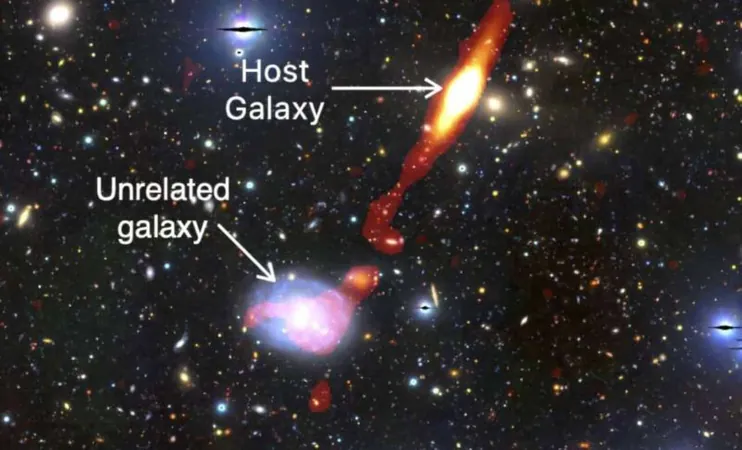
Astronomers Discover Colossal Radio Galaxy: A Cosmic Enigma 32 Times Larger Than the Milky Way!
2025-01-21
Author: Michael
Introduction
Astronomers have made a remarkable discovery in deep space: a gigantic radio galaxy named Inkathazo, which spans an astonishing 3.3 million light-years—32 times the size of our own Milky Way galaxy. This incredible finding was made possible by the advanced MeerKAT telescope in South Africa, and the name 'Inkathazo,' meaning 'trouble' in isiZulu and isiXhosa, aptly reflects the challenges this galaxy presents to scientists.
Extraordinary Plasma Jets
The extraordinary plasma jets emitting from the supermassive black hole at the galaxy's center have researchers scratching their heads. Unlike other similar cosmic phenomena, the structure of Inkathazo is baffling due to the unique bent shape of its jets, which defies conventional expectations for galaxies located within dense galaxy clusters.
A Surge in Giant Radio Galaxy Discoveries
The last five years have seen an explosion in discoveries of GRGs, largely credited to the cutting-edge sensitivity and resolution of telescopes like MeerKAT. 'The number of GRG discoveries has absolutely exploded thanks to powerful new telescopes like MeerKAT,' asserts Kathleen Charlton, a Master’s student at the University of Cape Town and lead author of the study.
Inkathazo: The ‘Troublesome’ Giant
The choice of name for this massive galaxy reflects its mystery and complexity. Kathleen Charlton explains, 'Inkathazo means 'trouble' because understanding the physics behind what’s going on has proven to be quite challenging.' One of the most puzzling aspects is the behavior of its plasma jets, which do not conform to the typical patterns seen in other GRGs; instead of extending straight, one jet appears notably bent.
Investigating the Physics Behind GRGs
To decipher Inkathazo's mysteries, scientists employed MeerKAT's high-resolution spectral age maps, allowing them to track energy distributions within the galaxy's plasma. Dr. Thorat notes, 'This discovery gives us a unique opportunity to study the physics of GRGs in remarkable detail.' These maps revealed that certain regions of the plasma jets are gaining unexpected energy boosts which could stem from interactions with hot gases present in the intergalactic medium.
Unveiling the Southern Sky's Hidden Treasures
The discovery of Inkathazo adds to our knowledge of a relatively uncharted region of the southern sky. Together with two other GRGs identified in the same cosmic patch known as COSMOS, this highlights the treasure trove of potentially undiscovered GRGs waiting to be found. 'The fact that we unveiled three GRGs by pointing MeerKAT at a single patch of sky suggests there's likely a vast number of undiscovered giants in the southern hemisphere,' explains Dr. Jacinta Delhaize, who spearheaded previous studies on GRGs.
Looking Ahead: The Future of GRG Research
The landmark discovery of Inkathazo represents just the tip of the iceberg for radio astronomy. As a precursor to the highly anticipated Square Kilometer Array (SKA), MeerKAT is set to pave the way for even groundbreaking revelations. 'We're entering an exciting era of radio astronomy,' says Dr. Delhaize.
The SKA is expected to dramatically deepen our understanding of the cosmos by focusing on critical areas such as: - Mapping the Southern Sky: Exploring additional regions for more GRG finds. - Refining Plasma Models: Investigating energy dynamics within the jets of GRGs. - Understanding Environmental Impact: Analyzing the influence of dense clusters on GRG evolution.
Through the insights gained from Inkathazo and other GRGs, we stand on the brink of unveiling cosmic evolution's secrets, shedding light on the processes that shape the largest structures in our universe.
Stay tuned as we continue to explore the wonders of the universe—who knows what other cosmic enigmas await us!









 Brasil (PT)
Brasil (PT)
 Canada (EN)
Canada (EN)
 Chile (ES)
Chile (ES)
 Česko (CS)
Česko (CS)
 대한민국 (KO)
대한민국 (KO)
 España (ES)
España (ES)
 France (FR)
France (FR)
 Hong Kong (EN)
Hong Kong (EN)
 Italia (IT)
Italia (IT)
 日本 (JA)
日本 (JA)
 Magyarország (HU)
Magyarország (HU)
 Norge (NO)
Norge (NO)
 Polska (PL)
Polska (PL)
 Schweiz (DE)
Schweiz (DE)
 Singapore (EN)
Singapore (EN)
 Sverige (SV)
Sverige (SV)
 Suomi (FI)
Suomi (FI)
 Türkiye (TR)
Türkiye (TR)
 الإمارات العربية المتحدة (AR)
الإمارات العربية المتحدة (AR)